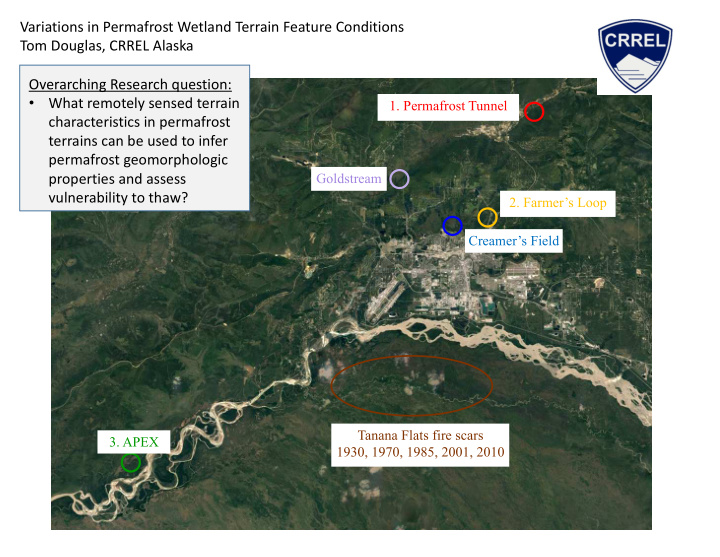



Variations in Permafrost Wetland Terrain Feature Conditions Tom Douglas, CRREL Alaska Overarching Research question: What remotely sensed terrain • 1. Permafrost Tunnel characteristics in permafrost terrains can be used to infer permafrost geomorphologic properties and assess Goldstream vulnerability to thaw? 2. Farmer’s Loop Creamer’s Field Tanana Flats fire scars 3. APEX 1930, 1970, 1985, 2001, 2010
Variations in Permafrost Wetland Terrain Feature Conditions Airborne LiDAR in 2014 and 2016 Airborne hyperspectral in 2016 1. Permafrost Tunnel Historical imagery to 1949 UAV testing and spectral meas. Ground based LiDAR Goldstream Veg. spectral reflectance 2. Farmer’s Loop Repeat thaw depths/active layer dGPS surveying Creamer’s Field Vegetation assessments Vegetation manipulations Moisture content, pH, Eh Microbiology Thermal measurements Electrical resistivity tomography Snow surveys Coring to 15 m depth Tanana Flats fire scars 3. APEX 1930, 1970, 1985, 2001, 2010
June-September Precipitation: Permafrost Tunnel- thermokarst driven hydrologic change 2014: 223% above mean Gently sloping upland terrain. 10m high ice wedges covered by ~3m of silt 2015: 156% above mean 2016: 183% above mean Downslope sedimentation/redistribution Permafrost Tunnel Initiation of thermokarst In the last few years Advanced thermokarst hydrologic change C. Hiemstra
Farmer’s Loop- Worldview 2 image and repeat LiDAR 0 500 m 0 2014-2016 LiDAR (meters) 500 m
Farmer’s Loop- Worldview 2 image and galvanic electrical resistivity tomography 0 Treed fen WC: 30-100 g/g Birch-white Tussocks and shrubs Spruce forest WC: 100-800 g/g Black spruce/moss WC: 30-100 g/g forest WC: 30-100 g/g 500 m 140 levation in meters 120 100 80 Trail 60 E lectrode spacing 6 meters Trail R MS error: 16.4 40 E 20 0 100 200 300 400 500 Distance in meters R esistivity in ohm-me ters 6400 12,800 100 200 400 1600 3200 800
Repeat thaw depth measurements along four 500 m long dGPS surveyed transects- one summer Birch-white Treed fen Tussocks and shrubs with increasing Black spruce/moss Farmer’s Spruce forest WC: shrub density forest Loop WC: 30-100 g/g 30-100 g/g WC: 100-800 g/g WC: 30-100 g/g Trail Trail
Birch-white Treed fen Tussocks and shrubs with increasing Black spruce/moss Farmer’s Spruce forest WC: shrub density forest Loop WC: 30-100 g/g 30-100 g/g WC: 100-800 g/g WC: 30-100 g/g Trail Trail
Birch-white Treed fen Tussocks and shrubs with increasing Black spruce/moss Farmer’s Spruce forest WC: shrub density forest Loop WC: 30-100 g/g 30-100 g/g WC: 100-800 g/g WC: 30-100 g/g Trail Trail
Birch-white Treed fen Tussocks and shrubs with increasing Black spruce/moss Farmer’s Spruce forest WC: shrub density forest Loop WC: 30-100 g/g 30-100 g/g WC: 100-800 g/g WC: 30-100 g/g Ice cemented silt Transition zone Tussock site: 60 cm <0°C in mid November Trail Trail
Repeat thaw depth measurements along four 500 m long dGPS surveyed transects- 4 years Birch-white Treed fen Tussocks and shrubs with increasing Black spruce/moss Spruce forest WC: shrub density forest Farmer’s WC: 30-100 g/g 30-100 g/g WC: 100-800 g/g WC: 30-100 g/g Loop Trail Trail Similar repeat patterns across all four transects
APEX site- snow depths in 2015 and 2016- repeated patterns of ecotype/terrain-snow relationships -Hoping to have IceBridge fly all sites in March, 2017 coincident with a large snow campaign Depth in cm 10 20 30 40 50 2015 2016 60 70 80 90 100 2015 2016 2016 Thomas.a.douglas@usace.army.mil
Recommend
More recommend